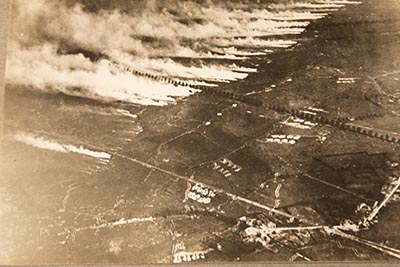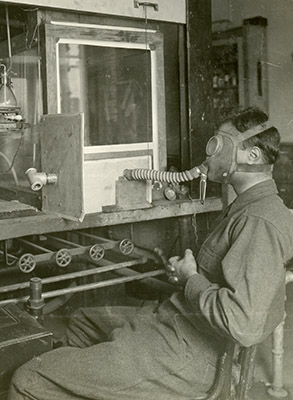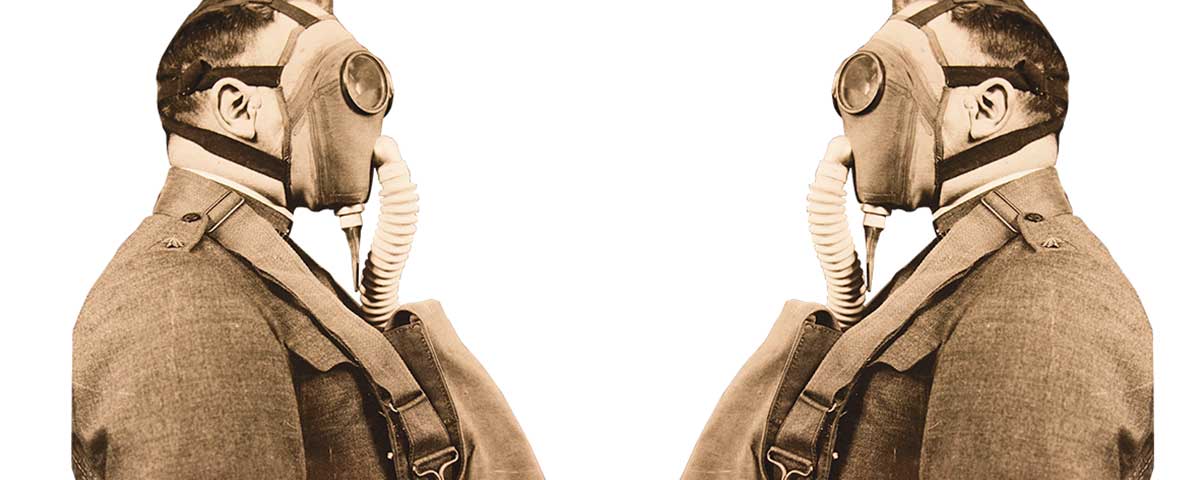On a hot afternoon in August 1918, the Chemical Warfare Service of the U.S. Army rolled into the village of Hastings-on-Hudson, N.Y., a small factory town on the banks of the Hudson River, 20 miles north of midtown Manhattan. The soldiers built their barracks along the main road outside the business district and stationed a garrison as the engineers went down to the waterfront. There, they put up about a dozen wood-framed buildings on the grounds of the Zinsser Chemical Company for the production of mustard gas. In case of explosion, the buildings were designed to blow outward so as not to collapse on the workers inside.
When the United States entered World War I in April 1917, the Army had to scramble to catch up to its Old World counterparts in every aspect of military preparedness. Germany held a towering advantage over its opponents, thanks to its chemical engineering expertise and its bold use of poison gases. In the United States, only chlorine had ever been manufactured on a large scale, and no facility was geared up to make the “king of battle gases,” mustard gas. The government’s solution was to contract with privately held chemical companies to manufacture poison gases.
One of the first was the Zinsser Chemical Company, whose president and chief chemist was Frederick Zinsser. Born in 1868 in New York City, Zinsser grew up in Hell’s Kitchen, speaking both English and German. His father, a chemist from the Rhineland, and his mother, an Alsatian homemaker, came to the United States in 1848. Frederick completed a degree in chemistry at Columbia University, and then spent three years at Heidelberg University in Germany, where he worked under the world’s most respected chemists, including Dr. Viktor Meyer, who first synthesized mustard gas in 1886. Zinsser returned to the United States and briefly worked in Manhattan before moving to Hastings-on-Hudson in 1897. He and his father, August, converted an old sugar mill on the Hudson River into a chemical plant. The Zinsser Chemical Company produced tannic acid and a dye made from gallnuts and alizarin that wool manufacturers used to give Army uniforms their distinct khaki color. By 1917 Zinsser’s business occupied more than a dozen buildings on the Hudson and employed some 200 chemists and laborers.
But it was Zinsser’s association with Viktor Meyer that caught the attention of the Chemical Warfare Service. “Gas is the cheapest, the most effective, and the most humane weapon to ensure our national safety,” said Zinsser. He was not alone in his belief that chemistry could bring the battlefield carnage to a swift end. Only the Germans had mustard gas in 1917, however, and its use was tipping the war in their favor.
 The Germans first used mustard gas at the Third Battle of Ypres, also known as Passchendaele, in July 1917. (By then, countermeasures to chlorine attacks were so effective that releases were primarily used to harass the enemy into wearing gas masks, which were difficult to breathe through and restricted vision.) Mustard gas is a colorless, oily vesicant, a blistering agent whose viscosity allowed it to cling to foliage, uniforms and even horse hair for up to a week. Toxic when inhaled, it caused temporary blindness, hoarseness and pulmonary inflammation. Unlike chlorine and phosgene, which completely dissipated after five to 10 minutes, mustard clouds settled in trenches and ditches and lingered for days in puddles and sinkholes. A soldier exposed to the oily gas could easily contaminate his entire unit with his soiled uniform. Zinsser described mustard as the “most important of all chemical compounds. . . . An area liberally sprinkled with mustard gas is an absolute barrier against attack and if weather conditions are favorable, will make a terrain thus treated impassable for days at a time.”
The Germans first used mustard gas at the Third Battle of Ypres, also known as Passchendaele, in July 1917. (By then, countermeasures to chlorine attacks were so effective that releases were primarily used to harass the enemy into wearing gas masks, which were difficult to breathe through and restricted vision.) Mustard gas is a colorless, oily vesicant, a blistering agent whose viscosity allowed it to cling to foliage, uniforms and even horse hair for up to a week. Toxic when inhaled, it caused temporary blindness, hoarseness and pulmonary inflammation. Unlike chlorine and phosgene, which completely dissipated after five to 10 minutes, mustard clouds settled in trenches and ditches and lingered for days in puddles and sinkholes. A soldier exposed to the oily gas could easily contaminate his entire unit with his soiled uniform. Zinsser described mustard as the “most important of all chemical compounds. . . . An area liberally sprinkled with mustard gas is an absolute barrier against attack and if weather conditions are favorable, will make a terrain thus treated impassable for days at a time.”
“At first the troops didn’t notice the gas and were not uncomfortable,” wrote Harry Gilchrist, medical director of the Gas Service of the American Expeditionary Force. “But in the course of an hour or so, there was marked inflammation of their eyes. They vomited, and there was erythema of the skin. . . . Later there was severe blistering of the skin, especially where the uniform had been contaminated, and by the time the gassed cases reached the casualty clearing station, the men were virtually blind and had to be led about, each man holding on to the man in front with an orderly in the lead.”
It is estimated that 30 percent of American battle casualties in 1918 were caused by exposure to mustard gas, though of those who had been wearing gas masks only about 3 to 4 percent died.
In November 1917, the Army purchased a large tract of land outside Aberdeen, Md., to be used as artillery proving grounds. A portion of this land, known as the Edgewood Arsenal, was set aside for filling explosive shells with toxic gas. Edgewood also began producing chlorine and phosgene. Mustard production did not begin until February 1918, when the British chemist Sir William Pope devised a new technique for the rapid manufacture of the gas, a procedure perfected by scientists at American University in Washington, D.C. “There is such a thing as creative chemistry,” said Zinsser. “The method which we [the Americans] developed in collaboration with the English chemists was very simple.”
But the Army could not meet the demand for gas. In August 1918, after the government agreed to finance new construction and equipment costs, the Zinsser Chemical Company and the National Analine and Dye Company in Buffalo, N.Y., were contracted to produce mustard gas in conjunction with the Edgewood Arsenal. Each facility, named for its location, was overseen by an Army representative and protected by a garrison to ensure the safety of military secrets and the safe handling of the poison gas, though mustard gas production was responsible for 674 casualties at Edgewood and its satellites between June and December 1918.
Edgewood Hastings, the Zinsser plant, was prepared for a daily production of 75 tons when the armistice was signed in November 1918. (It is unclear how much was ever actually produced.) Edgewood Maryland had a daily capacity of 100 tons; Edgewood Buffalo, 50 tons. In contrast, German plants were never able to produce more than 6 tons a day. “The German method of production, based on the work of Professor Meyer, was a very complicated and difficult one to put into practice on a large scale,” said Zinsser. “There is reason to believe that the willingness of the German high command to sue for peace was in a large measure due to their knowledge of what was in store for them.”
 The production of chemical weapons during World War I was an unprecedented collaboration between the government, research scientists and private industry. “Until 1914, the Germans had practically a world monopoly on organic chemicals,” said Zinsser. “Very few plants existed in any country outside Germany, and here in the United States only a few had the courage or backing to enter into competition with these strongly entrenched competitors.” Almost 2,000 scientists in the United States, and thousands of industrial workers, made chemical weapons research the largest government-funded research program at the time. “Factories and laboratories that in times of peace produce dyes, medicines, and perfumes can at short notice be changed into plants for munitions and gas, using practically the same apparatus, operated by the same skilled workmen and supervised by the chemists trained for the job,” said Zinsser.
The production of chemical weapons during World War I was an unprecedented collaboration between the government, research scientists and private industry. “Until 1914, the Germans had practically a world monopoly on organic chemicals,” said Zinsser. “Very few plants existed in any country outside Germany, and here in the United States only a few had the courage or backing to enter into competition with these strongly entrenched competitors.” Almost 2,000 scientists in the United States, and thousands of industrial workers, made chemical weapons research the largest government-funded research program at the time. “Factories and laboratories that in times of peace produce dyes, medicines, and perfumes can at short notice be changed into plants for munitions and gas, using practically the same apparatus, operated by the same skilled workmen and supervised by the chemists trained for the job,” said Zinsser.
What Zinsser describes in broad strokes would prove the foundation for the rise of American military-industrial might in the world created by the Great War. What’s more, the hazards of producing the toxic gases would lead to new standards for worker and soldier safety. But mustard gas in particular was so horrific in its effects, causing more chemical casualties than all other agents combined, that world opinion finally turned against the poisons, creating the climate for the first lasting agreement regarding chemical weapons.
Bans on chemical weapons had been tried before. Two decades earlier, at The Hague Conference of 1899, many of the major powers, including Imperial Germany, had signed an agreement pledging not to use poison gas in warfare. The United States refused to sign, its representative, Captain A.T. Mahan, calling the prohibition hypocritical. “It is illogical,” said Mahan, “to be tender about asphyxiating men with gas, when all are prepared to admit that it is allowable to blow the bottom out of an ironclad at midnight, throwing four or five hundred into the sea to be choked by the water.” Regarding the violations of this treaty in World War I, Zinsser observed: “Conventions and agreements are merely scraps of paper when a nation finds itself in a hopeless situation.”
The wreckage of the Great War, however, delivered a new impetus for compliance. In 1925, 37 countries, including the major belligerents in World War I, signed the Geneva Protocol for the Prohibition of the Use of Asphyxiating, Poisonous or Other Gases, and Bacteriological Methods of Warfare, which restricted the use of chemical weapons, although not their production or storage. (Both the United States and Soviet Union maintained large stockpiles of chemical weapons during the Cold War.) The last documented use of mustard gas came in 1988, when Iraqi president Saddam Hussein deployed it and other chemical weapons against Iraqi Kurds. Eliminating global stockpiles, however, would not commence until the Chemical Weapons Convention of 1993, and by December 2012, the United States had destroyed 78 percent (71,000 metric tons) of its declared chemical weapons, including 90 percent of agents in Category 1, which includes mustard gas, and all stockpiles of agents in other classifications. As of October 2013, 190 countries—representing 98 percent of the world’s population—had agreed to abide by the Chemical Weapons Convention. Only Angola, Egypt, North Korea and South Sudan had neither signed nor acceded to the convention.
David J. Jackowe is a physician and writer in Hastings-on-Hudson, N.Y.





